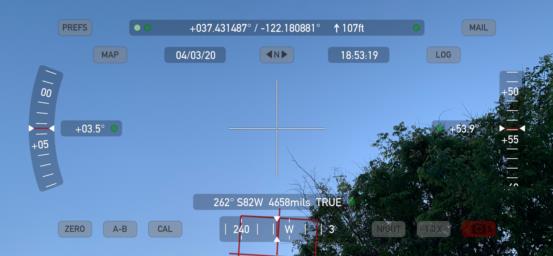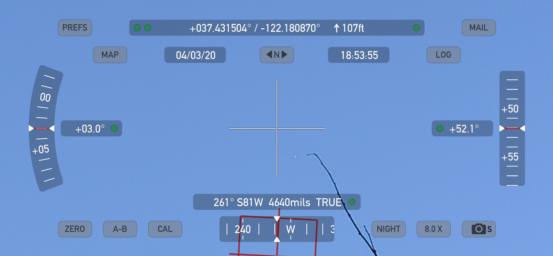
NavList:
A Community Devoted to the Preservation and Practice of Celestial Navigation and Other Methods of Traditional Wayfinding
Re: Venus in daylight
From: Peter Monta
Date: 2020 Apr 3, 20:40 -0700
Cheers,
Peter
From: Peter Monta
Date: 2020 Apr 3, 20:40 -0700
Another way to quickly see Venus in daylight is to use a smartphone app to position a landmark at the right azimuth and elevation. Attached are a couple of screenshots from "Theodolite", an iOS app. Here's the recipe I used a couple of hours ago:
- find a lamppost, tree branch, or building corner
- while viewing this object in the AR display, walk around until it has the right azimuth and elevation
- (optional) quick look through small binoculars, say 7x35, or the 7x35 monocular from a sextant
- enjoy the naked eye view
I'm not sure I'd trust the phone's compass to better than 10 degrees, especially near a steel-framed building, but that just means a slightly longer search along the circle of constant elevation (or one can use the Sun's azimuth to estimate the compass error). The elevation from the phone's accelerometer is pretty reliable, 1 degree-ish.
The first photo shows the general tree environment and the second shows Venus near the branch tip. The naked-eye visual experience was slightly better than this photo (Venus was more distinct), perhaps because of autofocus issues. The app should provide manual focus control when taking screenshots, but it doesn't.
- find a lamppost, tree branch, or building corner
- while viewing this object in the AR display, walk around until it has the right azimuth and elevation
- (optional) quick look through small binoculars, say 7x35, or the 7x35 monocular from a sextant
- enjoy the naked eye view
I'm not sure I'd trust the phone's compass to better than 10 degrees, especially near a steel-framed building, but that just means a slightly longer search along the circle of constant elevation (or one can use the Sun's azimuth to estimate the compass error). The elevation from the phone's accelerometer is pretty reliable, 1 degree-ish.
The first photo shows the general tree environment and the second shows Venus near the branch tip. The naked-eye visual experience was slightly better than this photo (Venus was more distinct), perhaps because of autofocus issues. The app should provide manual focus control when taking screenshots, but it doesn't.
The app shows the Sun and Moon as AR icons directly in the display; Venus would be a logical upgrade. The more astronomy-oriented planetarium-type AR apps will of course have Venus already, but I didn't have one of those handy.
Cheers,
Peter








